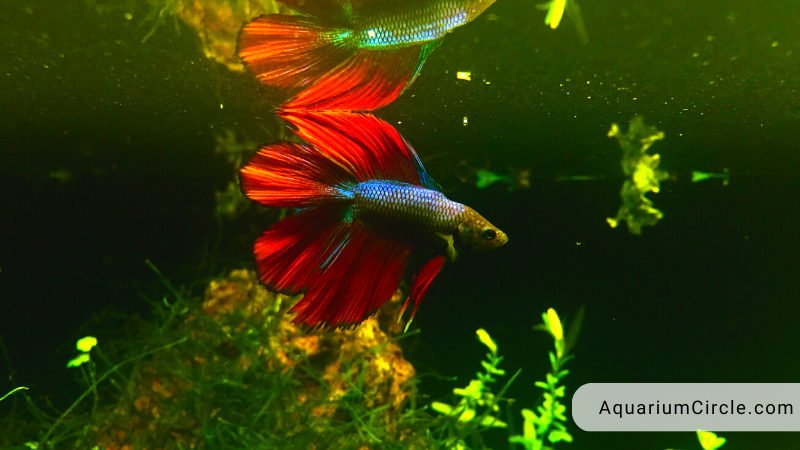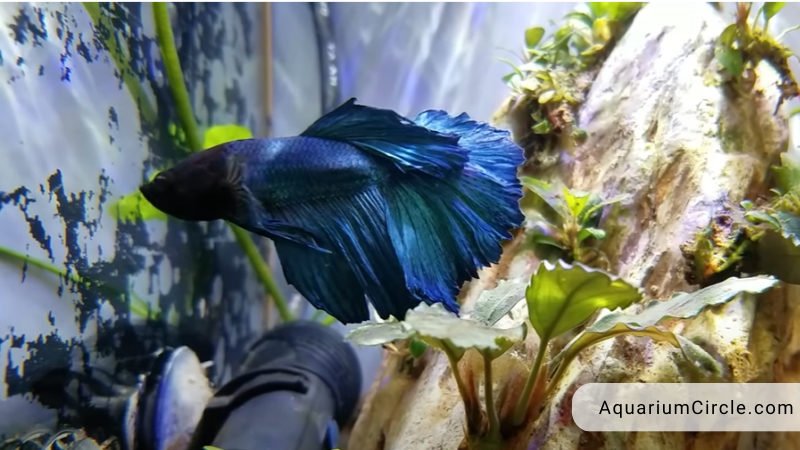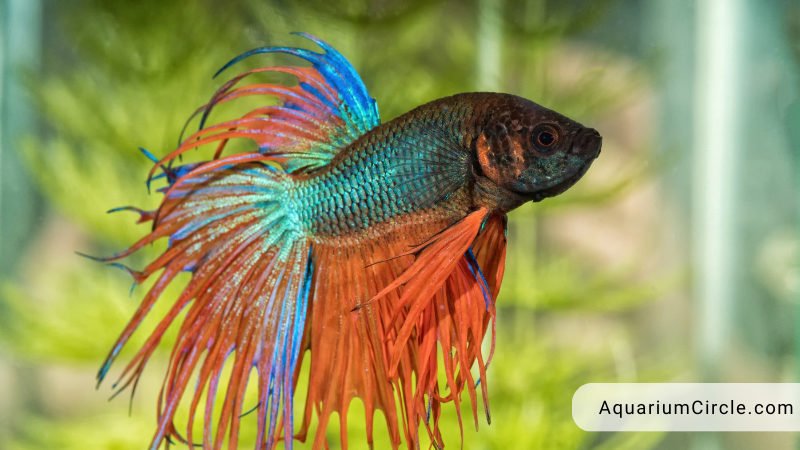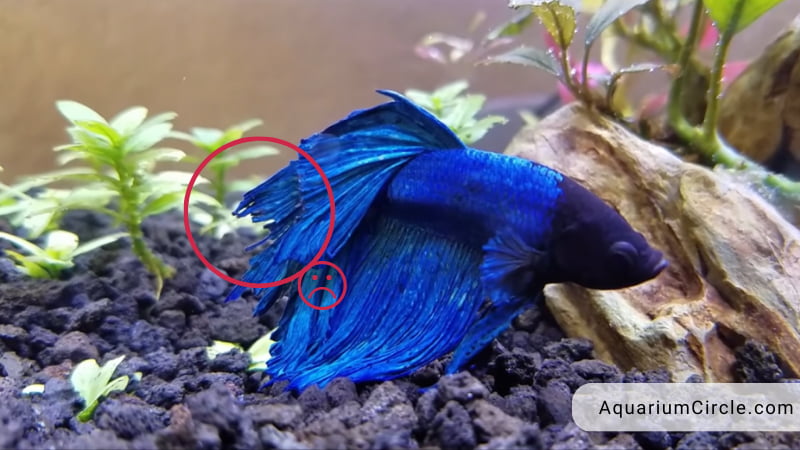Betta fish or Siamese fighting fish, known for their stunning colors and flowing fins, have become increasingly popular as pets in home aquariums. Their captivating beauty and unique personalities make them a favorite among fish enthusiasts. However, these graceful creatures can sometimes face health challenges, with fin rot being one of the most common issues they encounter. Betta fish Fin rot is a bacterial or fungal infection that affects the fins of betta fish, leading to discoloration, fraying, and eventual deterioration.
This blog post aims to provide a comprehensive guide on the prevention, identification, and treatment of Betta fish fin rot, ensuring that your beloved aquatic pets remain healthy and vibrant. By understanding the causes, recognizing the symptoms, and implementing proper care, Betta owners can effectively battle fin rot and support your betta fish on their journey to recovery.
See also:
- Healthy Betta Fish Vs Unhealthy: 9 Signs You Must Notice Before Your Pet Dies
- Swim Bladder Disease Betta – Betta Care To Be Aware Of
- Dropsy Betta – Symptoms, Causes And How To Treat Dropsy In Betta Fish
What Causes Betta Fish Fin Rot?

First and foremost, it’s essential to remain calm, as fin rot is a widespread issue among betta fish and is not typically fatal. This common affliction is caused by bacteria that are naturally present in your aquarium’s water. These bacteria only become problematic when your betta’s immune system is compromised, which you can address to prevent future occurrences.
Fin rot in betta fish is primarily attributed to suboptimal water conditions. Are the water temperature in your tank significantly below 78 degrees Fahrenheit, and is it cloudy with uneaten food and fecal matter? Cold water, elevated ammonia (>0 ppm) and nitrite levels (>0 ppm), and high nitrate levels (>20 ppm) can cause stress and weaken your betta’s immune system, that lead to fin rot.
Additionally, overcrowded tanks with too many fish can lead to rapid water quality deterioration, increased stress, and fin rot. Inconsistent feeding, which results in overfeeding or underfeeding, can also contribute to a weakened immune system.
Fin rot can also be triggered by fungal infections or other underlying diseases that have compromised the immune system or caused stress. It is not uncommon for a betta fish to suffer from multiple ailments simultaneously.
See also: How Many Betta Fish In A 10 Gallon Tank: Useful Guide
Betta Fish Fin Rot Symptoms

Detecting fin rot in its early stages is crucial for the successful treatment and recovery of your betta fish. By observing your betta regularly and being familiar with their appearance, you can quickly spot any changes that may indicate fin rot. Some common signs and symptoms include:
- Discolored or frayed fins: One of the first indications of fin rot is a change in the color of your betta’s fins, usually turning darker or even black at the edges. You may also notice that the fins appear frayed or torn.
- Fins becoming transparent or ragged: As fin rot progresses, the affected areas of the fins may become transparent or develop a ragged appearance. Over time, the fins may appear to be disintegrating or melting away.
- Slow or rapid progression of fin deterioration: Fin rot can progress at varying rates depending on the severity of the infection and the overall health of your betta fish. In some cases, the fins may deteriorate slowly over weeks, while in more aggressive infections, significant damage can occur in just a few days.
- White or fuzzy patches on fins: In some instances, fin rot may present itself as white or fuzzy patches on the fins, which can be a sign of fungal involvement in the infection. This symptom may also be accompanied by inflammation or redness at the base of the fins.
- Lethargy and loss of appetite: Although not specific to fin rot, a betta fish exhibiting lethargy and loss of appetite may be experiencing stress or illness. These signs can be an indication that the fish’s overall health is compromised, which can make them more susceptible to fin rot.
See also: Betta Fish Fins Look Ripped: Top Reasons & Magic Tips To Treat
To be clear, the symptoms described above are completely differrent from the conditions that will be mentioned right at the following part.
Differences between Betta fish fin rot and other conditions
It is essential to accurately differentiate fin rot from other conditions that may present similar symptoms. This ensures that your betta fish receives the appropriate treatment and care for their specific issue. Some conditions that can be mistaken for fin rot include:
- Fin biting: Betta fish may sometimes bite their fins due to stress, boredom, or poor water quality. Fin biting can result in ragged, torn, or uneven edges on the fins, similar to the appearance of fin rot. The primary difference is that fin biting often results in a more uneven pattern of damage, and there is typically no discoloration or inflammation. Addressing the underlying causes of fin biting, such as improving water in the tank quality or providing enrichment, can help resolve the issue.
- Fin regrowth: After recovering from fin rot or any other fin damage, betta fish may experience fin regrowth. During the regrowth process, the new fin tissue might appear thinner or more transparent than the original tissue, which could be mistaken for fin rot. However, fin regrowth generally does not involve discoloration, fraying, or inflammation, and the fins should continue to grow back over time.
- Genetic conditions: Some betta fish may have genetically predisposed fin abnormalities that can be mistaken for fin rot. These conditions can include curling or twisting of the fins, uneven fin growth, or other unusual fin shapes. It is important to recognize that genetic conditions are not the result of infections and do not require the same treatment as when you treat fin rot. Observing your betta fish over time and consulting with a veterinarian or an experienced aquarist can help you determine whether the issue is genetic or infectious in nature.
Betta Fin Rot Treatments

Promptly and appropriately treating your betta is essential for helping your fish recover from fin rot. By following these steps, you can increase the chances of a successful recovery and support your betta’s overall health:
Early intervention
As soon as you notice signs of fin rot, take action to prevent the infection from worsening. The earlier you intervene, the better the chances are for your betta fish to recover and regrow their fins.
Medication and treatment options
Several treatment options are available for addressing fin rot, and the best approach will depend on the severity of the infection and the specific cause:
- Antibacterial and antifungal treatments: Over-the-counter medications, such as broad-spectrum antibiotics (e.g., Kanamycin, Tetracycline) or antifungal agents (e.g., Malachite Green, Pimafix), can be effective in helping treat your fish condition. Be sure to follow the instructions on the packaging and consult with a veterinarian or experienced aquarist if you have any questions or concerns.
- Salt baths: A short-term salt bath using aquarium salt (not table salt) can help to reduce infection and promote healing. Dissolve 1 teaspoon of aquarium salt per gallon of water in a separate container, and gently place your betta fish in the solution for 15-30 minutes. Monitor your betta closely during the bath and return them to their main tank if they show signs of distress.
- Indian almond leaves: Adding Indian almond leaves to your betta’s tank can help to naturally improve water quality and boost your fish’s immune system. The tannins released by the leaves have antibacterial and antifungal properties, which can aid in the recovery process.
Monitoring and adjusting treatment
Keep a close eye on your betta fish during treatment to assess the effectiveness of the chosen way to treat. If the fin rot does not improve or worsens after a few days, consider trying an alternative treatment or consulting with a veterinarian for further guidance.
Supporting fin regrowth and recovery
Even after the fin rot has been treated, it is essential to continue supporting your betta fish’s recovery and fin regrowth. Maintain optimal water quality through regular water changes and testing, reduce stress by providing a stable environment and compatible tank mates, and ensure a proper, balanced diet for optimal immune health.
By taking swift action and following appropriate treatment protocols, you can help your betta fish recover from fin rot and regain their vibrant, flowing fins. Remember to consult with a veterinarian or an experienced aquarist if you have any concerns or questions about your betta’s health.
Fin Rot Preventions For Bettas

Prevention is always better than treatment when it comes to fin rot and other health issues in betta fish. By maintaining a healthy environment and taking care of your fish’s needs, you can significantly reduce the risk of fin rot in your betta fish. Here are some essential steps to prevent fin rot in betta fish:
- Maintain optimal water quality: Regular water changes and monitoring of water parameters, such as temperature, pH, ammonia, nitrite, and nitrate levels, are crucial for maintaining a healthy environment for your betta fish. Aim to keep the water temperature between 76-80 degrees Fahrenheit and ensure that ammonia and nitrite levels remain at 0 ppm, with nitrate levels below 20 ppm.
- Proper tank setup: Provide a spacious and well-maintained tank for your betta fish, with a minimum of 5 gallons of water, a heater, and a gentle filter. Include hiding spots and resting areas, such as plants and caves, to reduce stress and provide a sense of security for your betta.
- Reduce stress factors: Minimize stress by avoiding sudden changes in water temperature or parameters, keeping the tank in a quiet location, and providing a consistent day-night light cycle. If you have other fish in the tank, ensure that they are compatible with betta fish to prevent aggression and fin nipping.
- Balanced diet: Feed your betta fish a high-quality, varied diet that includes a mix of pellets, flakes, and occasional treats like frozen or live brine shrimp and bloodworms. A balanced diet will help to boost your betta’s immune system and maintain overall health.
- Regular health checks: Monitor your betta fish regularly for any signs of illness, injury, or stress. By catching potential issues early, you can take action to prevent complications, such as fin rot, from developing.
- Quarantine new tank mates: Before introducing new fish or plants to your betta’s tank, quarantine them for at least two weeks to ensure that your fish are free of diseases or parasites that could potentially harm your betta fish.
- Keep the tank clean: Remove uneaten food and debris from the tank regularly, and clean the filter and tank decorations as needed to prevent the build-up of harmful bacteria and waste.
See also: Betta Fish Plants: 17 Best Plants For Betta Fish
By following these preventive measures and providing a healthy, stable environment for your betta fish, you can significantly reduce the risk of fin rot and other health issues, ensuring your aquatic pet thrives and flourishes.
Video About Betta Fish Fin Rot
FAQs
Is fin rot contagious?
Yes, fin rot CAN BE contagious, especially in overcrowded tanks or when fish are exposed to poor water conditions. Proper tank maintenance and isolation of affected fish can help prevent the spread.
Can betta fish recover from fin rot?
Yes, with proper treatment and care, betta fish can recover from fin rot and regrow their fins. Early identification and intervention are crucial for a successful recovery.
How long does it take for a betta fish’s fins to regrow after fin rot treatment?
The time it takes for fins to regrow varies depending on the severity of the fin rot and the effectiveness of the treatment. It can take anywhere from a few weeks to several months for fins to fully regrow.
References

Annette M. Chaney is an experienced marine biologist with over 20 years of experience as an aquarist and fishkeeper. She started her first aquarium at a young age, filling it with frogs and goldfish obtained from the ten-cent pet store.
Annette grew up caring for and breeding African Cichlids, which led to a hobby in high school that doubled as a profitable means. Attending Reed College gave her time to solidify herself as an accomplished aquarium caretaker with an eye for sales. After that, from 2009 – 2013, she studied at Roger Williams University – one of the most prestigious universities for Aquaculture and Aquarium in USA. She is the founder of AquariumCircle since 2010.
